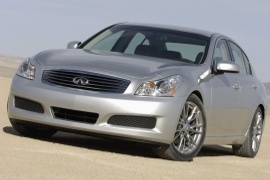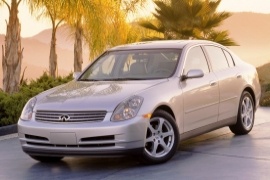INFINITI G35 Models/Series Timeline, Specifications & Photos
First production year: 2001
Engines: Gasoline
Infiniti refreshed the G35 lineup in 2005, and apart from some exterior changes, it went through an important upgrade on the interior.
Infiniti introduced the third generation of its premium compact-segment contender on the market in 2002. Still, by 2005, it looked already slightly outdated. But Infiniti didn't just replace a few chromed parts with other body-colored ones. Instead, it invested enough to make its customers feel like they are in a different, up-market vehicle.
From the outside, the main difference was at the front, where Infiniti completely changed the car's appearance. The new, boomerang-style headlights showed a more aggressive look than the older ones. Moreover, the grille featured a taller center section and a chromed surrounding. In addition, the bumper sported a different lower area where the apron was split into three, with a center grille flanked by two air intakes. At the back, there were new taillights and a new trunk lid with a cleaner aspect.
Inside, Infiniti installed a completely new dashboard. There were new dials with red needles and a much modern appearance. More importantly, the carmaker swapped the tachometer with the speedometer positions and placed an LCD display between them. In addition, the 2006 G35 received a new infotainment system on the center stack with a color display. Last but not least, the steering wheel was new, with re-arranged buttons and controls for the cruise control and the audio system.
Under the hood, Infiniti installed the same VQ35 engine but upgraded it to provide over 300 ponies. The most significant upgrade was the introduction of the AWD versions besides the standard rear-wheel drive ones.
The third generation of the G35 Sedan was a big evolution over its predecessor, which looked more like a Nissan Primera than a premium vehicle.
Nissan already had a very good RWD platform used for the 350Z, and it was cheaper to develop a vehicle based on that than to make a new one from the ground up. By 2001, Infiniti already had won some respect in the premium car market, which helped the G35 with the sales.
In 2001, the BMW 3-Series was the benchmark in the compact-sedan premium-segment. While it seemed difficult, Nissan's premium brand, Infiniti, challenged it with a design and a new platform. With an exterior drawn by Hiroshi Hasegawa, the G35 featured a longer hood, wide grille, and vertically mounted headlights. These details made the car look different in its class. From the sides, the coupe-like rear end of the cabin and the short decklid inspired sportiness.
Inside, Infiniti didn't want to play it light and installed a sport-inspired interior, with an instrument cluster that featured big dials for the tachometer and speedometer. The plastic center stack fascia mimicked an aluminum panel, and it was a pity. Thanks to a pair of front seats with high bolsters on the sides, the front occupants held their place while cornering. In the back, it was enough room for two and minimal for three passengers.
Like in many other situations, Infiniti disappointed the customers with the engine choice because it offered the G35 with only one option: a 3.5-liter V6 paired as standard to a 6-speed manual. A 5-speed auto was available as an option.

